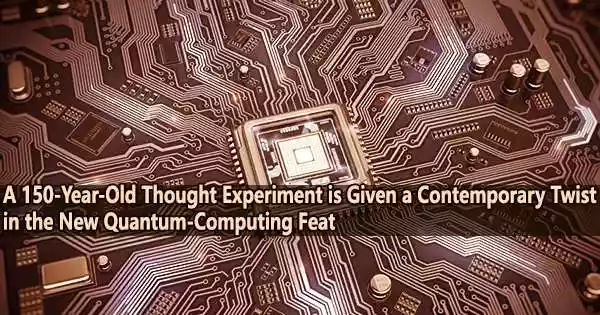An approach to reset a quantum computer, or to confidently prepare a quantum bit in the ‘0’ state, as required for trustworthy quantum computations, has been devised by a team of quantum engineers from UNSW Sydney.
The technique is remarkably straightforward; it is based on the antiquated idea of “Maxwell’s demon,” an omniscient creature that can distinguish between hot and cold gases in a gas by observing the speed of the individual molecules.
“Here we used a much more modern ‘demon’ a fast digital voltmeter to watch the temperature of an electron drawn at random from a warm pool of electrons. In doing so, we made it much colder than the pool it came from, and this corresponds to a high certainty of it being in the ‘0’ computational state,” says Professor Andrea Morello of UNSW, who led the team.
“Quantum computers are only useful if they can reach the final result with very low probability of errors. And one can have near-perfect quantum operations, but if the calculation started from the wrong code, the final result will be wrong too. Our digital ‘Maxwell’s demon’ gives us a 20x improvement in how accurately we can set the start of the computation.”
The research was published in Physical Review X, a journal published by the American Physical Society.
Watching an electron to make it colder
The team led by Prof. Morello has pioneered the use of electron spins in silicon for the encoding and manipulation of quantum information. They have also shown quantum operations with extremely low error probabilities and record-high fidelity.
Just by using a modern electronic instrument, with no additional complexity in the quantum hardware layer, we’ve been able to prepare our electron quantum bits within good enough accuracy to permit a reliable subsequent computation. This is an important result for the future of quantum computing. And it’s quite peculiar that it also represents the embodiment of an idea from 150 years ago!
Dr. Mark Johnson
The accuracy of setting up the electron in a known state as the starting point of the calculation was the final obstacle to effective quantum computing using electrons.
“The normal way to prepare the quantum state of an electron is go to extremely low temperatures, close to absolute zero, and hope that the electrons all relax to the low-energy ‘0’ state,” explains Dr. Mark Johnson, the lead experimental author on the paper. “Unfortunately, even using the most powerful refrigerators, we still had a 20 percent chance of preparing the electron in the ‘1’ state by mistake. That was not acceptable, we had to do better than that.”
Dr. Johnson, a UNSW graduate in Electrical Engineering, decided to use a very fast digital measurement instrument to ‘watch’ the state of the electron, and use real-time decision-making processor within the instrument to decide whether to keep that electron and use it for further computations. The effect of this process was to reduce the probability of error from 20 per cent to 1 per cent.
A new spin on an old idea
“When we started writing up our results and thought about how best to explain them, we realized that what we had done was a modern twist on the old idea of the ‘Maxwell’s demon’,” Prof. Morello says.
The concept of ‘Maxwell’s demon’ dates back to 1867, when James Clerk Maxwell imagined a creature with the capacity to know the velocity of each individual molecule in a gas. He would take a box that is filled with gas, has a wall in the center that divides it, and has a fast-closing door. The demon can open the door such that the fast (hot) molecules pile up on one side and the slow (cold) molecules on the other thanks to his understanding of each molecule’s speed.
“The demon was a thought experiment, to debate the possibility of violating the second law of thermodynamics, but of course no such demon ever existed,” Prof. Morello says.
“Now, using fast digital electronics, we have in some sense created one. We tasked him with the job of watching just one electron and making sure it’s as cold as it can be. Here, ‘cold’ translates directly in it being in the ‘0’ state of the quantum computer we want to build and operate.”
The ramifications of this finding are crucial to the future of quantum computing. It is possible to create a machine that can withstand some faults, but only if they occur infrequently enough. The typical threshold for error tolerance is around 1 percent. This applies to all errors, including preparation, operation, and readout of the final result.
This electronic version of a ‘Maxwell’s demon’ allowed the UNSW team to reduce the preparation errors twenty-fold, from 20 percent to 1 percent.
“Just by using a modern electronic instrument, with no additional complexity in the quantum hardware layer, we’ve been able to prepare our electron quantum bits within good enough accuracy to permit a reliable subsequent computation,” Dr. Johnson says.
“This is an important result for the future of quantum computing. And it’s quite peculiar that it also represents the embodiment of an idea from 150 years ago!”





